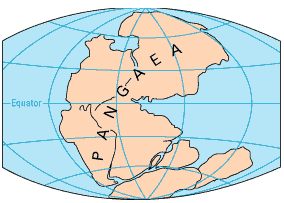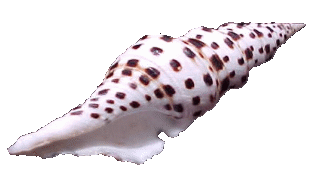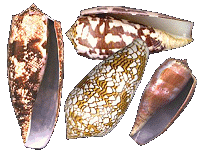|
Printer
Friendly version of article; but
beware, this prints out all 59 pages( Internet Express) or36 pages (Netscape)
(0.25 MB for the entire article). If you just want one section
printed out, go to the specific class section that you want(see individual
class sections listed at the bottom of this page).
|
|
The
Phylum Mollusca
(an Introduction, for High-school level students, and all others interested!!) |
By
Avril Bourquin
Science Editing by Ross Mayhew
May, 2000
| Note: | |
|
|
|
Early
Beginnings:
|
The time is now about 600 million years ago and the first molluscs have made their appearance on our world. About 100 million years later, during the Ordovician period, at least six of the seven classes of molluscs represented today were present. Many of these first molluscs were but simple, worm-like animals, having segments similar to what we find in annelid worms and arthropods. These first molluscs crawled about the primeval seas, probing for and eating microscopic bits of food.
|
The great landmass of Pangaea slowly deposits dissolved salts and other chemicals into the ocean. The first primitive molluscs in these oceans now digest these chemicals and begin to use the nutrients to build themselves protective shelters (shells) against their hostile environment. As Pangaea breaks apart around 200 million years ago, the world's great continents slowly migrate, due to plate tectonics, and we begin to recognize the world continents as they are today. |
 |
Over time, the molluscs flourish and evolve to fit newly developing habitats.
Fossil records show some groups ("taxa") growing larger, some smaller.
Some grow spiny, others, shiny. Some coil tighter, some looser. Some coil left
to right while others loose their coil all together. Some even loose their shells
completely. Some, like the ammonids, evolve into huge numbers of species, and
then mysteriously disappear forever only to be found as fossils. About 400 Million
years ago, some of these molluscs, first the bivalves,
begin to inhabit the worlds freshwater streams and lakes. It took at least another
300 million years for certain gastropods to evolve to where they were capable
of populating all land and freshwater water habitats.
During the last million years, the land and freshwater molluscs have
evolved very rapidly; however, some groups of marine molluscs appear to be decreasing
in the number of species existing.
Today, molluscs live in almost all parts of the world. From the deepest
ocean trenches to high up on our mountains, molluscs have found their niche.
The number of living species ranges from a very conservative 50,000 according
to Brusca & Brusca (Invertebrates 1990) to 60,00 in Rupert & Barnes
Invertebrate Zoology (sixth edition 1994) to 100,000 in Kozloff's Invertebrates
(1990). That said, it is quite likely that up to half a million species will
eventually be formally discovered (see the article on How to name a Species, for
how this is done!), since many environments and the deeper parts of the sea-floor
are very poorly known even today! Classification and taxonomy of molluscs
can vary widely depending on what school of thought.
One thing does remain constant in all molluscs however; - to survive all molluscs must have moisture. To stay alive, they must keep their soft bodies moist at all times and for some like those which live in hot dry deserts environments, this is done by curling up in their shell, secreting a mucous plug and staying holed up until the next bit of moisture comes along.
|
What
is a Mollusc?
|
The word "mollusc" or "mollusk" (both are correct)
is derived from the Latin word mollis meaning "soft". The study of
molluscs, "malacology", comes from the Greek word for soft, malacos.
The term "conchology" is also used for the study of molluscs; however,
it is usually applied to those that study the shell only.
Molluscs, in general, are soft-bodied animals that usually produce an external skeleton (called an "exoskeleton") we call a Shell, which is composed of a limey material: calcium carbonate (CaCO3) The shell serves both protective, and supportive purposes. The one feature common to all molluscs is the presence of a fleshy mantle. This is a fold or lobe (or a pair of them) of fleshy material, which secretes, modifies and lines the shell.
Members of all classes except the bivalves possess a ribbon-like set of hooked teeth called radula. These they rasp (think of a fingernail file) back and forth over their food much the same idea as a cat lapping up milk: Vegetarian species use them to scrape algae off rocks and other substrates, while most molluscan carnivores use them to penetrate the surface of their prey - even when that is a decent thickness of shell!
|
In the superfamily Conoidea (which includes the Cones and the largest family in the mollusc world the Turridae), the radula is specialized into a form of miniature "harpoon", which is used to spear prey, and in many cases, to deliver powerful neurotoxins, to paralyze their hapless victims. |
|
 Turris babylonia (Linne, 1758 ) Picture courtesy of Ross Mayhew |
 Miscellaneous Conidae Picture coutesy of Paul Monfils |
Most molluscs have a well-defined nervous system with a primitive brain. Molluscs have a circulatory system and most have a two-chambered heart. Their digestive system usually includes a jaw, pharynx, esophagus, stomach, intestine and anus. They have a reproductive system that produces eggs and/or sperm. Most gastropods and cephalopods have eyes and tentacles.
|
The
Molluscs we recognize today are divided into seven divisions called "classes"
Let us take a very brief look at these classes now: |
||||
|
||||
|
||||
|
||||
|
||||
|
||||
|
||||
|
||||
|
Now
Let's Take a More Detailed Look at The Phylum Mollusca
|
A phylum is usually defined as group
of animals having several features common to all or most of
its members. The following features are common amongst most molluscs:
|
Biologists use various methods for estimating how closely species are related to each other. They look at comparative anatomy, genetics and paleontology (the study of fossil organisms) to help form their theories. Changes within a population (a group of organisms of one species) generally occur due to divergence and speciation. |
|
Divergence within a phylum can occur whenever the population is split into two or more groups with no chance of interbreeding. Divergence is generally brought about by such events as habitat changes or competition for food. |
|
Speciation can result from reproductive isolation (populations can be physically isolated, as in many marine species, without being isolated reproductively, due to larval (veliger) stages which can drift for long distances, thus effectively "connecting" geographically remote populations. On the other hand, behavioral, morphological or reproductive differences in a small segment of a population can gradually lead to reproductive isolation, without much physical segregation. These reproductively separated populations will adapt to different conditions in different regions, via "natural selection" (i.e., survival of the fittest!). They may develop different mating behaviors or breeding seasons, or they may accumulate enough genetic differences to render egg and sperm incompatible. It is due to an accumulation of these changes and other morphological and genetic differences that we have the seven classes of molluscs today. This seemingly advanced degree of differentiation, however, took place hundreds of millions of years ago: by the middle of the Ordovician period, all the shell-bearing classes (6) of mollusc are represented in the fossil record. |
Now, let's take an even
closer look at these seven classes of molluscs. We'll cover the basic anatomy
and physiology and behavior of each group, and a variety of other interesting
facts about each. Enjoy!
The two first two classes we will discuss - the Aplacophorans and the Polyplacophorans,
are often regarded by some as Subclasses of a larger Class called Amphineura:
(Amphineura: (am-phi-neur-a) Latin: amphi =both. neura =nerve).
However, we will follow the crowd (i.e., the majority of scientists),
and treat them separately.
|
This is a new counter system set up by Globel on December 01, 2002 |